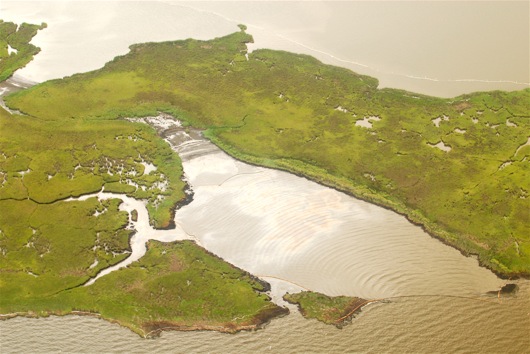Helicopters over Deep Water Horizon and Questioning Media in the Gulf, Part 1
We wake up in Mobile, Alabama, early, and head for Houma, Louisiana. We’ve arranged to get on a BP-sponsored helicopter flight over the Louisiana bayou and head offshore some 60 miles to the site where this whole thing started, where many oilmen died in an explosion. I’m with an activist from the Audubon Society and we’re driving well over 90 to get there on time. With us will be two NOAA scientists, one a biologist, one a geophysicist/oceanographer.
BP runs these sorties for media and has been for several months. The helicopter has 15 seats. I’m excited, not because I get to ride in a helicopter, but because I get nearly three hours to drill the BP guy and the scientists. Already seated are reporters from several major outlets, one, an NPR journalist trying to get good audio in a helicopter. Every time I ask a question, she turns her mic on. I’m doing her job for her.
Taking off, I ask the BP guy about the flight plan for our route. He doesn’t understand what I mean. Who chose it? I’m wondering if we’re seeing what’s really out here or if we’re seeing what they want us to see. He remarks that the journos choose the route, but what he means is they choose the destination. How we get there is up to BP and we’re not flying as the crow does. This is theater.
I take pictures of the wetlands, boom, slick, and some oiled beaches. The NOAA scientists champion the fact that of 77,000 miles of shoreline, only 600 are affected by oil. I don’t know what to do with this statistic. It sounds like an impressive ratio; then again, 600 miles is the entire collective coastline of Oregon and Washington State.
To get an accurate picture of this place you’d need to fly the same route every few days to see what is changing, not what it looks like in one isolated moment. Nonetheless, the photogs start clicking away whenever we come across “incriminating” pictures. But no one is asking questions and it’s driving me absolutely insane. How on earth can any good reporter pass up an opportunity like this?
I strategically place myself next to the BP employee and the scientists. I have a list and I’m going to get answers. The NOAA folks are cooperative, at times emotional. The BP employee is as cool as a cucumber; moreover, he doesn’t seem to know much. Every time I ask him a question he says, “I have all that information back on land, I’ll get back to you on that.”
Dispersants – this is what I want to know about. Specifically Corexit 9500 and 9527 (the ones used in this spill). This stuff is toxic as hell if it comes into acute contact with an animal. The effects of chronic, or low-level exposure aren’t known and that’s at the root of the fear that permeates the fishing community.
I talk to John Whitney, a NOAA Oceanographer who worked on the Exxon Valdez disaster. He gives me a crash chemistry lesson. Corexit is an extremely volatile compound. What this means is that it biodegrades very quickly – it has a half life of three to four days, which means after a few weeks it’s entirely gone, reduced to water and carbon dioxide. There are other volatile compounds produced in the degradation process, but no one can name one other than benzine. But it’s the middle of August now. If BP quit using dispersants on July 15th as they say they did, then it’s gone.
Entirely.
The dispersed oil remains, however, and the toxic poly aromatic hydrocarbons (PAHs) will persist, and not only on the surface. They’re stratified in the water column. PAHs are bad. Real bad. Having them dispersed isn’t a good thing either, especially when you have plumes from the surface leading way, way down. Dispersed means more surface area and more surface area means more biomass comes into contact with it. But NOAA is very rosy (like a dozen, red) on this subject, citing their report that states 75% of the oil is gone – dissolved and gobbled up by microbes. Dissolved? I wouldn’t drink it.
They show me charts reflecting findings that the toxicity isn’t anything to worry about. But only two days prior to this, I was in D’Iberville, Mississippi, looking at Flipcam footage shot by fisherman showing beyond a shadow of doubt that oil plume persists in Mississippi Sound. I only get them on the record saying that it’s all “mostly” gone or in such low concentrations that it doesn’t matter. It matters, all right.

























NO COMMENT
Leave a comment